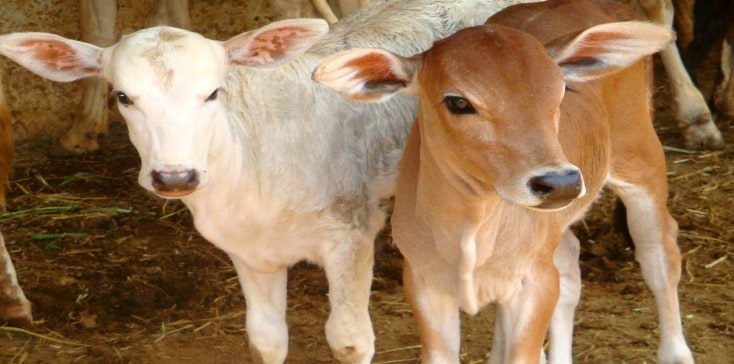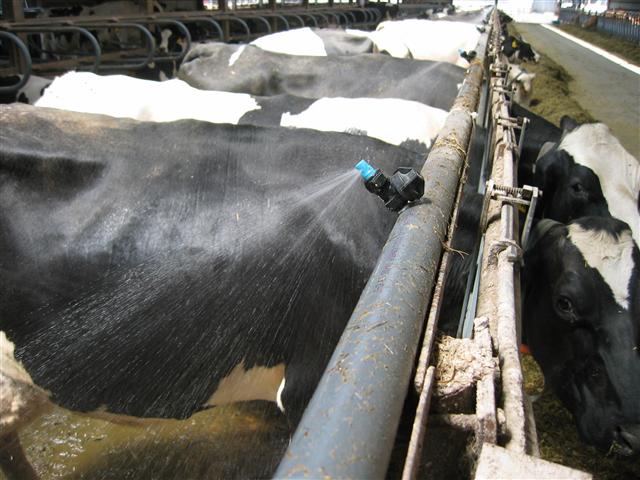
Cooling Systems to Protect Cows from Heat Stress
Most of India experiences a severe summer from April to July, with temperatures soaring to about 45 degrees Celsius. In such harsh weather, dairy cows need protection from ambient heat (environmental heat), else they suffer from Heat Stress Syndrome. This ailment leads to reduced dry matter intake, increased rectal temperature, respiratory rate, and hormonal responses and affects reproduction and milk production.
Research has shown that dairy cows are most comfortable between temperatures of 24 and 30 degrees Celsius. There are, however, differences between native breeds and crossbred cows; native breeds are thought to be more resilient. Cows that are high producers of milk are at an increased risk for Heat Stress Syndrome since their metabolic heat production is higher. Farmers therefore should consider various measures to mitigate heat stress.
Shade to Protect from Solar Radiations: In order to protect cows from heat stress the most pressing issue to consider is protecting them from solar radiation since it increases surface temperature of cattle and disturbs their hair-level heat dissipation mechanism. Ambient temperature and humidity should be considered while determining measures to reduce heat stress. When air temperature is higher than normal body temperature it increases net heat load (Body temperature and environmental temperature collectively). Hence protection from solar radiation by providing adequate shade should be the first step in reducing heat stress. There are wide options available for farmers ranging from thatched traditional roof to insulated roof. Height of roof is important; higher roof would provide better heat mitigation. Metallic or asbestos roof should always be avoided as these add to solar radiation. Shade of a tree is quite comfortable for animals hence providing shaded trees around the shed is a sure way of providing protection from solar radiation.
Soaking Cattle Skin in Water: Many farmers think that spraying water on cattle or soaking skin with water will reduce heat stress. Research has shown that merely soaking skin might help cattle if the ambient temperature range is 30-31 degree Celsius. In tropical climates, however, merely soaking with water is not enough as research has shown that skin moisture evaporates in just around six minutes and hence repeated soaking would be required which is not a feasible option. Additionally, this method requires lot of water which is a scarce resource and also leads to wet floor promoting microbial growth and mastitis.

Studies have also shown that sprinkling cows with water before they enter the shade reduces their respiration rate and rectal temperature by almost 50%, provided that each cow is soaked with at least 1.5 to 1.8 L water. The benefits of doing this were found to be greater than using only one of the two methods – only bringing them in the shade, or only soaking them with water.
Many sprinkler designs to soak cows are available in the market. For more details on supplier’s visit the ‘Directory’ of www.indiancattle.com
Soaking Cow Skin and Forced Airflow: Robust evidence is available that sprinkling cows combined with supplemental airflow causes rapid change in their body temperatures. The effect was found to be better than just using a fan or sprinkling. Sprinkling and air flow together have a larger impact on dissipation of heat from a cow’s body. The rate of heat stress is reportedly reduced by 2-5 times when frequency of sprinkling and air flow is increased.
 Research recommends that soaking the hair of cattle once every five minutes with an air flow rate of 9.5 to 12.8 kmph leads to reduced rectal temperature and relief from heat stress. It should be noted that high pressure systems that only cool air temperature are not good, rather, one should look for low or high pressure systems (Sprinklers) that also soak cow skin. These studies have shown that soaking cow skin with around one litre of water within 1-1.5 minutes and providing air flow for next 4 minutes is ideal to keep cows comfortable and protected from heat stress. Many sprinkling fans in a range of sizes are available in the market. Visit our directory at www.indiancattle.com to know more.
Research recommends that soaking the hair of cattle once every five minutes with an air flow rate of 9.5 to 12.8 kmph leads to reduced rectal temperature and relief from heat stress. It should be noted that high pressure systems that only cool air temperature are not good, rather, one should look for low or high pressure systems (Sprinklers) that also soak cow skin. These studies have shown that soaking cow skin with around one litre of water within 1-1.5 minutes and providing air flow for next 4 minutes is ideal to keep cows comfortable and protected from heat stress. Many sprinkling fans in a range of sizes are available in the market. Visit our directory at www.indiancattle.com to know more.
Evaporative Cooling: Soaking cattle skin does not work effectively in high temperatures and under conditions of high solar radiation. In this case, the skin heats up leading to quick evaporation of water. Soaking may transiently give some cooling effect but later on discomfort is increased. The best cooling method is air-conditioning, however it can be impractical due to high energy costs. Another solution is the evaporative cooling (With the help of fogers) of cows and barns wherein water is evaporated as it enters the shed.
This is well-suited to hot, arid, or semi-arid climates. It should, however, be kept in mind that this method increases the relative humidity of the barn, decreasing the method’s effectiveness to reduce heat stress. It is therefore recommended that the relative humidity must not increase beyond 70%. Evaporative cooling is thus not effective in areas of high humidity. In such areas, soaking cattle skin and using the air flow method is more suitable. Evaporative cooling also increases feed intake and milk production. It must be stressed here that the evaporative cooling system requires correct barn design, with proper cross ventilation to maintain the rate of air flow. In cases where there is inadequate ventilation, evaporative cooling systems will not help, and might even harm the cattle in long-run.
Practical Solutions for Small-hold Farmers: For resource-poor small-hold farmers, the most practical solution is loose housing with trees to provide shade along the periphery, and a shade at least 8-9 feet high, thatched with straw for insulation. If the farmers can cultivate grass in patches around the barn, the breeze entering the barn will help reduce its temperature. It is important to keep animals untied, as they alone are in the best position to decide if they want to be in the open or in a shaded area. Availability of water and easy access would help greatly.
Considerations in Choosing Cooling Systems
- Provide shed of sufficient height and insulation for protection from solar radiation. This should always be the first step in any cooling system.
- In order to minimize energy costs, determine when cooling will be most effective. Even in humid environments, evaporative cooling during noon and the afternoon may be of benefit. For details on suppliers of cow cooling systems in India, visit the resource directory in indiancattle.com
- If environmental temperature is above cow body temperature, any form of evaporative cooling will benefit the cows. It is always better to use all the three methods; that is shade, soaking, and evaporative cooling.
- Consider the cost of sophisticated systems, as any additional milk production due to better systems might not offset expenses. Also consider the availability of electricity in your area.
